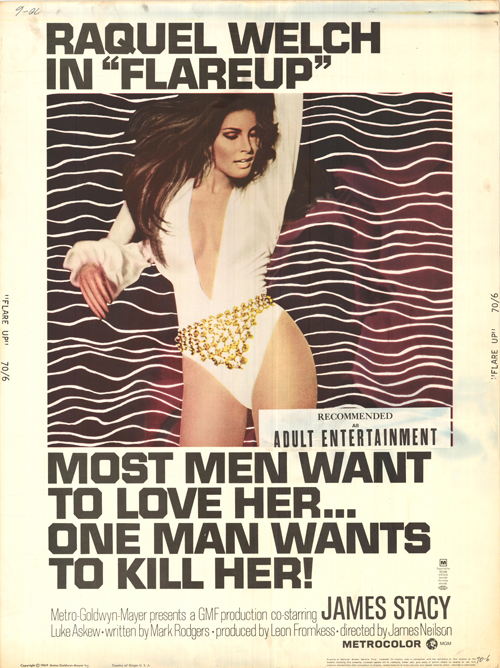B-MOVIE BULLSH*T - Part Twenty "The Hips, The Legs, The Torso!"
 Monday, May 28, 2012 at 6:00AM
Monday, May 28, 2012 at 6:00AM B-Movie Bullsh*t
Part Twenty
Flareup
(1969)
Synopsis
Michele, a Las Vegas dancer, watches helplessly as her friend Nikki is shot by Alan, her disturbed ex-husband. Alan blames Michele for the end of his marriage and makes it clear that he’s going to kill her too. She flees to Los Angeles to get away from him and quickly finds work in a club called The Losers, where she meets Joe, a handsome parking valet who instantly takes a liking to the gorgeous young woman. Alan soon learns where Michele is and hitchhikes to L.A.—killing an innocent motorist along the way. He confronts Michele and chases her through a zoo at night, but she’s saved by a pair of cops. Suffering from traumatic shock, she’s kept safe in a local hospital, but she decides to run and escapes through her window, only to find Alan waiting at the apartment she shares with Joe. Alan tells her he’s going to make her watch Joe die before killing her, but she manages to set him on fire before that happens. Even though Alan is dead, Michele still feels compelled to run and tries to get Joe to come with her to Mexico. He refuses and she drives off, only to turn back around and jump into his waiting arms.
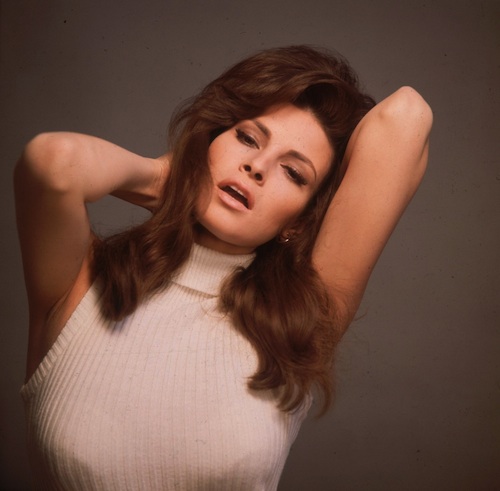
There is a melancholy aspect to Raquel Welch’s career that I personally find very affecting. She was a performer whose appearance was so extraordinary that it transcended mere sex appeal to that of an onscreen joke—she was so gorgeous that she actually became a caricature of herself. But unlike other actresses who possessed this same quality—Marilyn Monroe, Jayne Mansfield, Anita Ekberg—she bristled at the notion of being portrayed as a living cartoon.
It didn’t help that her career really began to take off just as living cartoons were becoming passé in favour of more realistic representations. Jane Fonda could make the transition from Barbarella to They Shoot Horses, Don’t They?, but she possessed a gift for dramatic acting Welch did not share. Welch’s gifts were best suited for light-hearted fare (her best performances can be found in such amusing trifles as Bedazzled, One Million Years B.C., The Last of Sheila and Richard Lester’s two Muskateer films), but her desire to be taken seriously compelled her to seek out roles that only served to prove why no one did.
A perfect example of this is found in Flareup—a film seemingly designed to exploit Welch’s sex goddess persona, but which turns out to actually be a misbegotten attempt to transform her into a dramatic leading lady. While the film’s memorable trailer plays up her character’s career as a go-go dancer, it fails to mention that it shows all of the dancing she does in the film. What we’re left with instead is a very poorly written thriller featuring a lot of unconvincing performances in a production as ambitious as any TV cop show from the era.
Writing about Sophia Loren and Gary Cooper, Pauline Kael once wondered why audiences were so invested in their acting abilities. Why wasn’t it enough that they simply looked better on camera than anyone else in the world? Watching Welch dance at the beginning of the film, it does make you wonder why this isn’t an achievement worth truly celebrating. The fact is that Welch isn’t even a particularly talented dancer, but she’s such a magnetic presence it’s impossible to take your eyes off of her. Then she stops dancing and starts emoting and all of the joy is sucked out of the picture.
It does make you wonder why one form of performance is considered so much more important than another. While it is true that Welch could have never played Jane Fonda’s role in Klute, it is equally true that Fonda—for all her big hair and abundant Barbarella curves—could never have held the screen as expertly as Welch does in Flareup’s one dance sequence. Both feats require skill and charisma, yet as far as everyone is concerned, Fonda’s is the only one that counts.
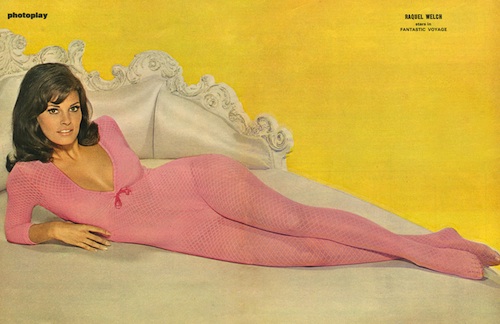
That said, even Fonda couldn’t have saved Flareup from self-destructing. Watching the film, it feels like it’s based on a first draft of a script that needed at least six more revisions before it was actually filmable. The structure is terrible. The first act is so rushed that we never get a sense of why we should give a fuck about anyone we’re watching, while the second meanders interminably with scenes between Michele and Joe that are so banal as to be ridiculous (until they get on the horse, where it’s just flat out ridiculous).
But the script’s biggest problem is Michele, whose impulsive need to run is a character trait screenwriter Rodgers had to establish to justify the idiotic decision she makes at the beginning of the final act. Rather than making her seem wounded and complex, he only succeeds in making her appear confused and flat-out stupid. Despite this, I was about to give him credit for a least staying true to the character he created during the film’s final scene, until he caved in and gave me the happy ending I’d been dreading.
The script is also unnecessarily homophobic, including not one but two gay characters whose sexuality ultimately adds nothing to the plot. I have no problem with a scene where Michele rejects another dancer’s advances if it were to pay off later in the movie, but it’s an utter non sequitur that goes nowhere. And apparently it wasn’t enough to justify the bartender's snitching on Michele to Alan by making him a junkie; he also has to be a gay junkie with a crush on his dealer. Again, I wouldn’t mind this if it had anything to do with the rest of the plot.
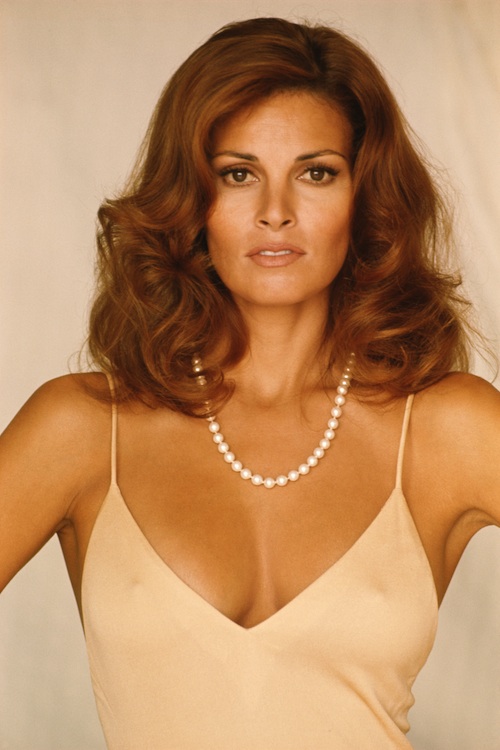
It doesn’t help that director James Neilson, who was 60 at the time, directs the film like a glorified TV episode—the only thing at all cinematic being the nudity seen in the first few minutes. I’ve long argued that the clearest sign of a filmmaker’s indifference isn’t when they ignore their script, but rather when they remain faithful to it even when logic dictates a change should have been made.
A good example of this comes in the scene where a police officer reads out the details from the killer’s file, including his year of birth—1945. The problem with this is that this establishes that Alan is 24, even though Luke Askew—the actor playing him—was 37 at the time and very much looked his age. It literally would have taken a second for Neilson to tell the actor playing the cop to say “1935” instead, but the fact that he didn’t proves how little he was invested in creating a credible product.
(I should also mention the hilarious onscreen error where—as the stuntman playing Alan flails around in flames—the nozzle of a fire extinguisher can clearly be seen rising up into the camera's frame. Apparently the shot was deemed too important to sacrifice even though it's impossible not to spot this blunder, no matter how hard you try.)
Sadly, the best thing about Flareup is the performance by James Stacey as Joe. I say this because—once again proving my thesis that the IMDb is the most depressing website on the Internet—it turns out the Emmy-nominated actor was forced to “retire” in the 90s when he served a six year prison sentence for molesting an 11 year-old girl. This shouldn’t affect the experience of watching him, but it really kinda does, especially since Joe is portrayed as the ultimate good guy.
Welch followed Flareup with Myra Breckinridge, another attempt at relevance that ended up being an even a bigger (albeit much more memorable) disaster. She had slightly better success with Hannie Caulder and Kansas City Bomber, but it wasn’t until her supporting performance as the clumsy Constance in The Three Musketeers that audiences got to see how much fun she could be onscreen when she stopped trying so hard.
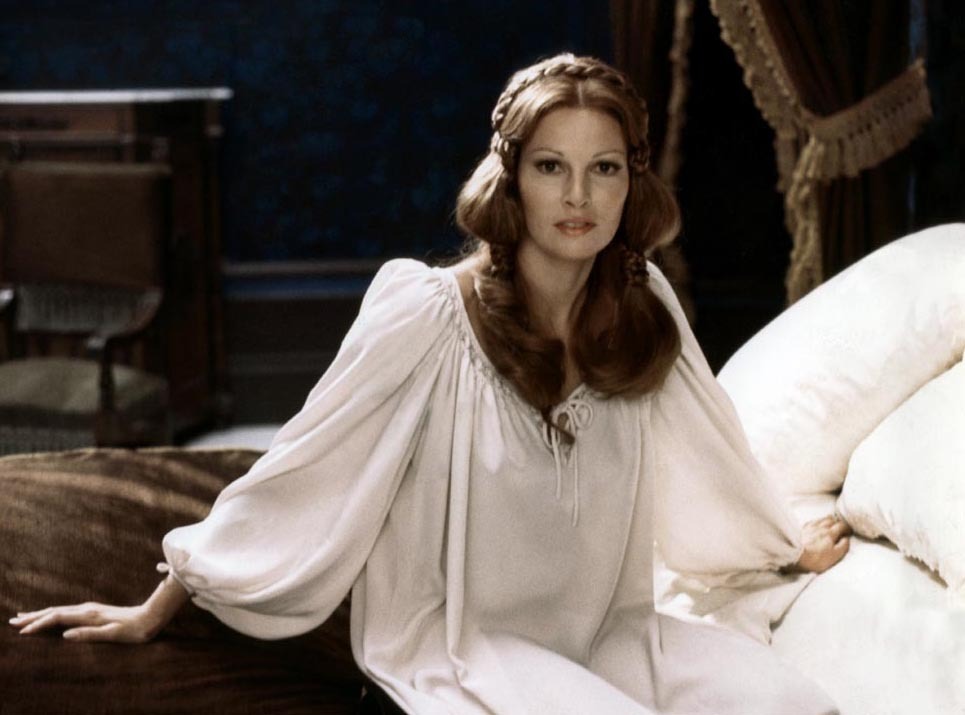
By then, though, it was too late. Within a few years she found herself spoofing the image she tried so hard to shed on Mork & Mindy (in an episode Robin Williams has publically described as the mark of the show's decline) and was fired from David S. Ward’s 1982 film Canary Row after 5 days of shooting (reportedly for her diva-like behaviour, but in her successful multi-million lawsuit against the producers, she argued that she had been given the part so the film could obtain its financing, only to be fired and replaced by the director’s preferred choice—Debra Winger—after filming began and it was too late for the financiers to pull out).
In his great book Hype and Glory, Oscar-winning screenwriter William Goldman asked us to consider who the better actor is—Laurence Olivier or Arnold Schwarzenegger. A seemingly no-brainer, he went on to remind us that while Arnold would be terribly cast in productions of Hamlet or Richard III, Larry would have been equally as useless in The Terminator or Conan the Barbarian. In other words, there’s a huge difference between being a great actor and a great movie star.
Raquel Welch was never going to be the former, but in a different place and time she could have been the latter. I know this because I’ve seen and own a copy of her greatest achievement—her million-dollar 1970 TV special Raquel! which I’m going to have to discuss in detail sometime soon.
Until then, I urge you to give Flareup a miss.

